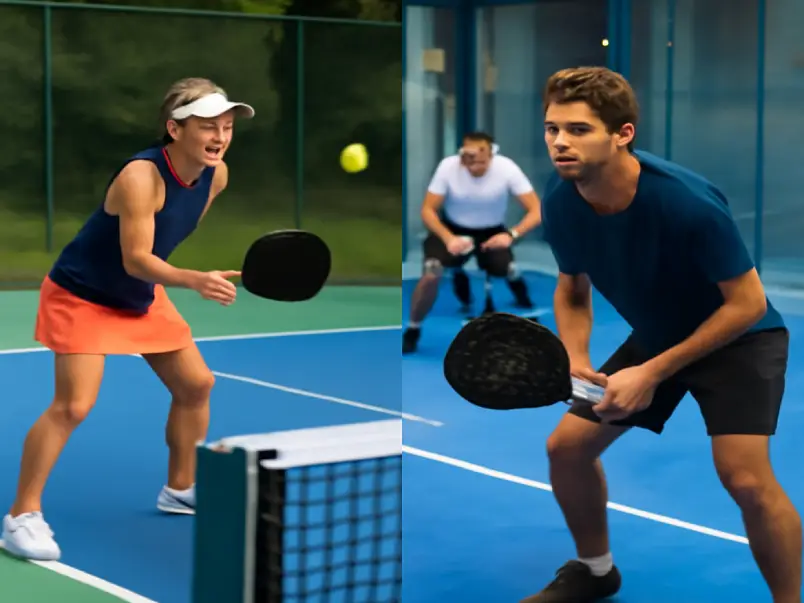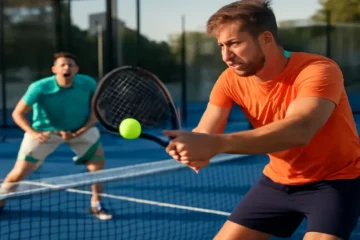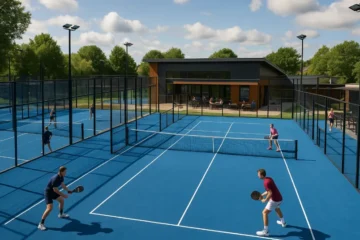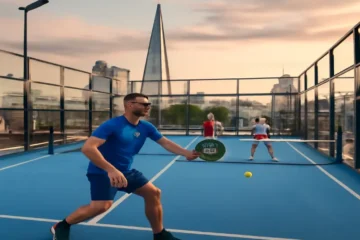The sporting world is witnessing an exciting, unprecedented phenomenon—two racket sports are experiencing explosive growth and taking over global courts. Padel and Pickleball, though distinct in their origins, rules, and appeal, are both claiming the title of the fastest-growing sports in the world. What’s most remarkable is that they’re thriving simultaneously, each catering to different demographics, forging new business models, and creating unique cultural niches.
Pickleball, a quirky-sounding hybrid of tennis, ping-pong, and badminton, is sweeping the United States, capturing the hearts of millions. On the other side of the globe, Padel, a strategic mix of tennis and squash, is already a prominent fixture in Europe and Latin America, growing in both popularity and prestige. Despite the similarities in their meteoric rise, these two sports are on divergent paths toward dominance. In this article, we’ll explore how these sports are developing, focusing on key battlegrounds—demographics, infrastructure, professional leagues, and future potential.
Round 1: Defining the Contenders – What Are We Even Talking About?
A. Pickleball: The People’s Champion
Pickleball has taken the American sporting scene by storm. It’s a sport that feels as easy to pick up as a casual game of backyard badminton, but with a competitive edge that has made it addictive for all ages. Played with a paddle and a lightweight wiffle ball, Pickleball courts are roughly the size of a badminton court, making it easily adaptable to a variety of spaces.
Core Gameplay: Players use a paddle to hit a wiffle ball back and forth over a net. The game has the underhand serve of tennis but is played on a much smaller court, which minimizes running and makes it ideal for all ages and fitness levels.
Key Appeal: Pickleball’s simplicity is its strength. It’s easy to learn, doesn’t require high-end equipment, and offers an engaging experience even for beginners. There’s a distinct social component to the sport, as it’s often played in doubles and is common in community centers, recreational parks, and even repurposed tennis courts.
Vibe: Accessible and community-driven, Pickleball tends to draw people from a wide variety of backgrounds. It’s often described as a “third space” activity, offering social interaction in a relaxed, fun atmosphere. The sport is known for its grassroots origin, with informal pick-up games happening in almost every community park.
B. Padel: The Strategic Socialite
Padel, a game that’s already a fixture in Europe, Latin America, and the Middle East, brings a different flavor to the world of racket sports. Though similar to tennis, Padel introduces a unique twist, played with a solid paddle and a depressurized tennis ball on an enclosed court with glass walls.
Core Gameplay: In Padel, players use paddles made of composite materials, and instead of bouncing the ball off the ground, the walls are also used to keep rallies alive. This dynamic makes the game fast-paced and tactical, requiring strategic shot placement, agility, and teamwork.
Key Appeal: While it’s easier to pick up than tennis, Padel’s skill ceiling is much higher. The game encourages players to use the walls strategically, adding a layer of complexity. Its appeal isn’t just in the game itself but in its social aspect, often played at exclusive clubs or resorts.
Vibe: Padel is synonymous with a premium, sophisticated social experience. It’s often described as the sport of the elite, with a focus on quality over quantity. In many countries, it’s a club-based activity, often played at exclusive, purpose-built sports centers that cater to professionals and high-net-worth individuals.
Round 2: The Battle for Players – Demographics and Accessibility
A. Pickleball’s “Big Tent” Strategy
One of the key reasons behind Pickleball’s rapid rise is its accessibility. Unlike tennis or Padel, which require more space, more equipment, and a higher skill level to play at a competitive level, Pickleball is relatively easy to learn, and its smaller court size makes it ideal for urban spaces.
Primary Driver: A significant portion of Pickleball’s early growth is attributed to its appeal among older adults (50+). This demographic is looking for a low-impact sport that provides a good workout without putting undue stress on the joints. The sport’s relatively low physical demands make it perfect for this group, especially in retirement communities or as part of a social wellness initiative.
Expanding Base: However, Pickleball isn’t just for older players. Gen Z and Millennials are quickly picking up the sport, drawn by its social aspect, low barrier to entry, and competitive potential. Its popularity has expanded across age groups, attracting families and young professionals alike.
The “Pickleball Easy” Factor: With fewer technical skills required to enjoy a casual rally, Pickleball provides instant gratification. This makes it appealing to beginners, as players can get into the action immediately without extensive training. And since it’s easy to organize informal games, Pickleball has found its place in parks, community centers, and schools, increasing its accessibility even further.
B. Padel’s “Lifestyle” Appeal
Padel, in contrast, caters more to the urban professional seeking an active, social outlet. While it’s easier to start than tennis, the game has a significant learning curve that can take years to master. Padel’s appeal is tied to its status as a “lifestyle sport,” offering more than just a way to get fit.
Primary Driver: Padel primarily attracts young professionals between 25 and 45. This demographic is drawn to the sport for its blend of physical activity and networking opportunities. Often played at exclusive clubs, Padel appeals to those seeking both leisure and a means to build social connections within a premium environment.
The “Country Club 2.0” Vibe: Padel is quickly becoming a status symbol in certain regions. With high-end clubs, luxury resorts, and international events, Padel’s image is rooted in sophistication, positioning itself as a sport of choice for those who can afford the time and membership fees to indulge in a more upscale activity.
The Skill Ceiling: Although the game is easier to pick up than tennis, mastering the nuances of wall-based play and advanced strategy elevates Padel into a sport with a high skill ceiling. The social aspect of the sport allows players to participate at any skill level while continually improving their technique.
Round 3: The Battle for Infrastructure – Courts, Clubs, and Capital
A. The Pickleball Land Grab
Pickleball’s infrastructure strategy revolves around adaptability. The sport’s rapid growth has led to the creation of a significant number of new facilities, many built by repurposing existing tennis courts or converting vacant spaces into dedicated Pickleball courts.
Adaptation: Tennis courts have become a prime target for Pickleball, and in many cases, cities and communities are converting courts into Pickleball-specific spaces. This approach makes the sport relatively easy to scale without requiring large capital investments.
Low Barrier to Entry: Pickleball’s infrastructure is relatively inexpensive to build. It’s easy to convert existing spaces, and the sport doesn’t need a specialized court to get started. The low cost of building courts, combined with the sport’s popularity, has led to a surge in facilities across the U.S. and beyond.
Grassroots vs. Corporate: While Pickleball started as a grassroots movement, the sport has attracted major corporate investment. Organizations such as Major League Pickleball and partnerships with large media companies like ESPN have brought professional attention to the sport, setting the stage for its next phase of growth.
B. The Padel Club Model
Padel’s infrastructure needs are more specialized. Unlike Pickleball, Padel requires a dedicated court enclosed with glass and mesh walls. This makes it a more expensive and complex sport to build from an infrastructure perspective.
Purpose-Built: The sport’s courts need to be enclosed, which requires more capital investment. While smaller Padel courts exist, the standard for professional and recreational play is a full-size court.
The Membership Model: Many Padel clubs operate under a membership model, tying the sport to exclusive private clubs. This creates a premium ecosystem that often attracts an affluent demographic, further cementing the sport’s image as a lifestyle activity.
Global Blueprint: In countries like Spain and Argentina, the Padel model is well-established, with countless clubs and courts. This infrastructure is now being replicated in cities worldwide, albeit with a significant investment required.
Round 4: The Professional Scene – Leagues, Stars, and Media Rights
A. Pickleball’s Professional Hustle
Pickleball has already made a significant impact on the professional sporting scene. With a growing number of competitive leagues, sponsorship deals, and social media-savvy influencers, Pickleball is firmly establishing itself as a legitimate professional sport.
Media Savvy: Pickleball has embraced the digital age, with excellent social media campaigns and celebrity investors, including major names like LeBron James and Tom Brady. This has helped push the sport into the mainstream, attracting younger audiences and generating more media coverage.
League Structure: Multiple competing tours such as the Professional Pickleball Association (PPA) and Major League Pickleball (MLP) are fueling its growth. These organizations provide structure and legitimacy, although the fragmented nature of the leagues might pose challenges down the road.
Broadcast Deals: Pickleball is now being broadcast on major sports networks, such as ESPN and the Tennis Channel. This broadens its reach and adds legitimacy to its professional landscape, providing a platform for the sport to grow further.
B. Padel’s Global Tour
Padel has its own well-established professional scene, with the World Padel Tour (WPT) leading the charge. This unified, global circuit is attracting the best talent from Spain, Argentina, and Brazil, and has become the gold standard for competitive Padel.
World Padel Tour (WPT): The WPT has successfully created a global brand for professional Padel, similar to the ATP and WTA tours in tennis. It’s the ultimate destination for professional Padel players, offering a clear path to international competition.
International Flavor: Padel’s strong roots in Spain, Argentina, and Brazil have helped create a fiercely competitive and globally relevant professional circuit. While its profile in North America is still growing, Padel has a massive following in Europe and the Middle East.
Broadcast Reach: The WPT has secured a strong broadcast presence in its core markets. However, unlike Pickleball, Padel is still building its profile in the United States, where the sport’s professional scene remains relatively niche.
The Verdict: Coexistence or Conquest?
As the race for supremacy heats up, both Pickleball and Padel offer distinct value propositions. Pickleball is well on its way to becoming a mainstream American sport, with a focus on accessibility, community, and low barriers to entry. Padel, on the other hand, is carving out its niche as a sophisticated, high-skill sport with global appeal, particularly among young professionals.
In the long run, both sports are likely to coexist, catering to different aspects of the market. Pickleball will continue to thrive as a community-focused, easily accessible activity, while Padel will remain a premium, strategic sport for those seeking a more refined and competitive experience.
Conclusion: The Winner Is… The Player
At the end of the day, the real winner in this sporting revolution is the public. With Pickleball and Padel gaining traction, players now have more choices than ever for an innovative, social, and enjoyable way to stay active. Whether you’re drawn to the fast-paced rallies and wall strategies of Padel or the easy-to-learn fun of Pickleball, one thing is certain: the future of racket sports has never looked more diverse or exciting.
FAQs
What is the difference between Pickleball and Padel?
Pickleball is a hybrid sport that combines elements of tennis, ping-pong, and badminton, played on a smaller court with a paddle and wiffle ball. Padel, on the other hand, is a fast-paced sport played with a solid paddle and a depressurized tennis ball on an enclosed court with glass walls, often associated with a more sophisticated, social atmosphere.
Which sport is easier to learn, Pickleball or Padel?
Pickleball is generally easier to learn, especially for beginners. The game’s smaller court, simple rules, and slower pace make it accessible for people of all ages. Padel, while easier than tennis, has a steeper learning curve, requiring players to master strategy and use the walls for rallies.
What age group plays Pickleball and Padel?
Pickleball appeals to a wide range of age groups, especially popular among older adults (50+) seeking low-impact exercise, but also gaining traction with younger generations like Millennials and Gen Z. Padel primarily attracts young professionals (25-45) due to its strategic nature and social aspect, often played in premium clubs or resorts.
Which sport is more social, Pickleball or Padel?
Both sports have a strong social element, but Pickleball is often seen as more accessible and community-driven, with many casual games taking place in public parks and recreation centers. Padel has a more exclusive social vibe, often played at private clubs and upscale venues, fostering networking and high-end leisure experiences.
Are Pickleball and Padel expensive sports to play?
Pickleball is generally inexpensive to get into, as it requires fewer specialized courts and equipment. Padel, however, can be more costly due to the need for enclosed courts and membership at private clubs, which can increase the overall expense of playing.
How are the professional leagues of Pickleball and Padel structured?
Pickleball has multiple professional leagues, including the Professional Pickleball Association (PPA) and Major League Pickleball (MLP), offering a competitive landscape. Padel has the World Padel Tour (WPT), a unified and global circuit akin to the ATP/WTA tours in tennis, with significant international reach and media presence.
Which sport has better global growth potential, Pickleball or Padel?
Pickleball is expanding rapidly in the United States and is poised to become a mainstream sport. Padel, while well-established in Europe, Latin America, and the Middle East, is growing rapidly in North America and is positioned as a premium sport with global appeal. Both sports have strong growth potential but cater to different demographics and infrastructures.




